A beginner’s guide to living in the Tuscan countryside
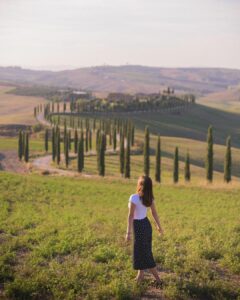 Why Tuscany?
Why Tuscany?
At the risk of being compared to "Eat Pray Love" during our travels (although Lauren does have something of young Julia Robertsness about her), we both admittedly had an affinity to spend an extended period of time in Italy, specifically Tuscany. Maybe we’ve watched “Under the Tuscan Sun” too many times (too often we passed abandoned villas and “joked” about restoring them in hopes of a pregnant Sandra Oh showing up), but the thought of getting wine drunk in the Italian countryside and indulging in pasta, pizza, and carbs galore sounded too heavenly to pass up. In addition to being the food capital of Italy (though it depends on which Italian you talk to), its central location is perfect for visiting plenty of traditional and off-the-beaten-path destinations throughout Italy.
Most reasonable people can agree that Italy has unmatchable cuisine, culture, scenery, and history to explore. We had both been to Italy before, but Lauren, never having been to Tuscany, understood the “hype” that surrounds the Italian experience, but never actually felt the affliction herself. She thought that maybe an extended visit would spark the same passion that others had for the capital of pasta. Rachel had previously been to Tuscany and fell in love with the beautiful scenery and charming city of Florence, and was ready to be cast in an Italian romantic comedy of her own.

In addition to all of Italy’s wonders, Rachel and Lauren both had dreams of grape stomping “I Love Lucy” style at an Italian winery, and the initial plan was to work on a winery during the harvest season. Our Italian dreams were quickly dashed after speaking with a few wineries and discovering due to the intensity of harvest season, there would be little to no time for us to devote to our online jobs. Lucky for us, we simultaneously discovered how affordable long term Airbnbs are in Tuscany, and decided this was the best option for us.
We know how overwhelming it can be to jump through the logistical hoops that is planning any trip to a foreign country, especially when planning extended stays affordably. We had some episodes of trial and error, and we’ve compiled a sort of “guide” in the hopes of helping others avoid the same pitfalls and also to share some of the things we did right!
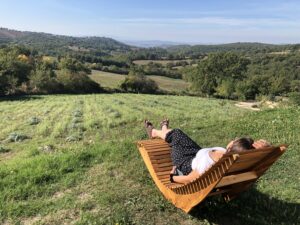 Our experience?
Our experience?
We ended up finding a great two-bedroom Airbnb in the heart of Tuscany and 50km west of Florence for the month of October (the $400.00/month price tag may have swayed this decision). Although we stayed for an entire month, we felt that we could’ve easily stayed for even longer. Tuscany has so much to offer that we felt like we only scratched the surface of things to do and see in the region.
We are, however, glad that we stayed for at least a month because it somewhat allowed us to build a routine. Though not every day looked the same, we were able to work online most mornings, exercise, and cook our own meals (which we’ve learned is a big deal for us). These small pieces made our time in Tuscany feel like less of a “vacation” and more of an actual lifestyle. We split our time between visiting the wineries of the Montecarlo region and visiting destinations like Florence, Pisa, Saturnia, and Cinque Terre. To facilitate the ease of making these trips and logistical things like groceries, we opted to rent a car (yes you guessed it, the same POS Fiat 500) for the month.

We are certainly leaving Tuscany with plenty of great stories, including some hiccups (a flat tire and getting stranded in Florence overnight to name a few...). After a day of aimlessly walking through the streets of Florence drinking cheap Tuscan wine with new friends, Lauren finally found the affection for Italy that she had been hoping for, and Rachel has mastered the Italian driving style (watch out, everyone). We think that everyone should experience their own “Under the Tuscan Sun” moment at least once in their life.
There’s something enchanting about the idea of Italy in the summertime, but as we’ve both found on our previous trips during the high season, the mixture of heat, humidity, and hoards of other tourists can distract from an otherwise amazing experience (not to mention free water can be hard to come by). As is our habit for a lot of our travels, we chose to spend our month long stint in Italy during shoulder season, in this case, the fall.
We did this for two reasons; our original plan was to spend some time on a vineyard during the grape and olive harvest seasons (which morphed due to other constraints), and we were hoping for less crowds and more moderate temps. Tuscany in October slows to a calmer rhythm, but the wine still pours just as steadily. The weather remained in the 60s and 70s and there was still plenty of fresh produce to enjoy. One of the treats of touring Italy in October is that you can taste olive oil that was pressed just hours before; it doesn’t get fresher than that!
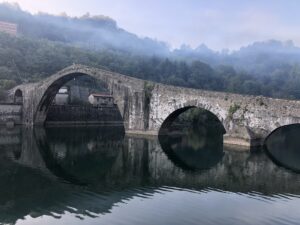 What to expect?
What to expect?
Pasta, pizza, and carbs are definitely things to expect during an extended stay in Tuscany, but the authentic experience goes beyond wining and dining. The biggest takeaway for us from Italy was definitely learning to take things slow. So to enjoy Tuscany (& Italy) for all it has to offer, sometimes it’s best not to have an agenda and learn to go with the flow (easier said than done for two East Coast girls). This also means that if you do have a rigid schedule and need to be places at a specific time, plan for extra time and try not to sweat the small stuff (like the Italian’s total disregard for punctuality). Italians believe that life is meant to be enjoyed and it’s hard to walk away from an experience like this and not feel the same.
With that said, the one thing we found that the Italians do not take so slow is their driving; If you choose to rent a car in Italy, expect to feel on-edge as Italian drivers constantly wiz around you and aggressively ride your tail if they don’t deem your speed fast enough. Italian auto and moped drivers look at traffic laws as mere suggestions, so you would do your best to keep your wits about you. We aren’t really sure why they do this (it’s like they’re in a big rush to go absolutely nowhere), but nonetheless it’s part of living there.
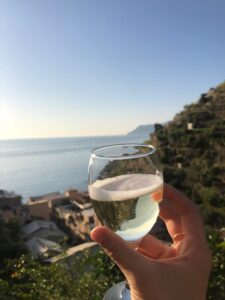
Though their driving is sometimes a little chaotic and anxiety-producing, overall the Italians are a relaxed group. This also means expect there to be strange closing times for stores (generally 1-2 hours in the middle of the day) for lunch and relaxation. This is not as true for the big cities, but we certainly felt this in the countryside. Stores are almost always never open late either (no midnight grocery runs for us). Additionally, being a predominantly Catholic nation, expect complete store closures on Sundays in the countryside. For us, this meant that we had to be sure we stocked up on groceries on Saturday. There are some restaurants that keep Sunday hours, but for the most part we tried to have food for Sundays in advance.
The water is safe to drink in Italy, but, as Americans, we always struggle with the lack of free water in Europe. The only positive thing about being forced to buy water in restaurants was Lauren was converted to a sparkling water fan (it’s like a party in your mouth). Make sure to carry an empty water bottle with you to seize the opportunity of refilling it at a water fountain (yay free tap water!).
Overall, expect to be amazed by breathtaking views, diverse landscapes, and delicious food. Italy has a lot to offer and though our expectations were high, we felt that it really did live up to the hype.
Where to stay?
We knew from the start that we wanted to stay in an authentic Tuscan town, and try to experience a little bit of the everyday life of real Italians. We ended up jumping on a property in the small town of Torre (you can barely find it on a map) and were surrounded by a small community of adorable Italian grandmothers and people who spoke no English. There was a small bodega across the street from our apartment where we could pick up the basics and hilariously try to exchange pleasantries in very rough Italian.
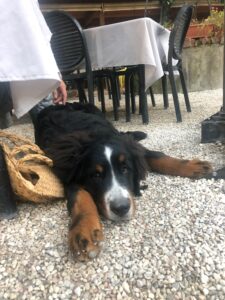
The thing we appreciated most about our little house was that we were never farther than thirty minutes to some of the best wineries in the region (and possibly the world), a little over an hour drive from Florence, and a fifteen minute drive from downtown Lucca.
We appreciated having our own space and the serenity of our remote location, but we did drive into Florence for a couple overnight trips to live out our “A Room With a View” fantasies (sadly there was no George Emerson to our Lucy Honeychurch). A very classic and affordable option with a central location is the Hotel Machiavelli Palace (they also had one of the best continental breakfasts we’ve ever seen). We recommend booking in advance for their balcony room to get the proper Florence experience!
Getting around?
There are many different options for transport in Italy, including public transit, car rentals, moped rentals, and walking. Just a quick note when planning to rent either a moped or car in Italy, you’ll need an International Driver’s License (we suppose that some people follow rules in Italy). There are some agencies that will overlook this, but for a $25 fee and 10 minutes of your time at a AAA before your travels, it’s well worth the investment.
After trying public transit for a few days, we quickly decided that our tumultuous relationship with the Italian transit system was not not meant to be. Living out in the countryside, there was a bus, but it did not come often and was not very reliable. After several mishaps, including one bus just not showing up leaving us totally stranded, and another zooming right past us without stopping, it took us over 4 hours to get to downtown Florence (a journey that takes just over an hour by car). We would only recommend relying on public transit if you are close to a city, not tied to any schedule, and willing to go grey over the chaos that is reading an Italian bus schedule.
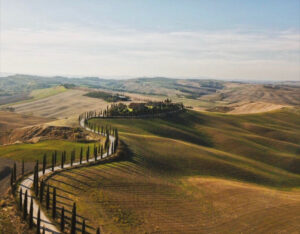
While public transit wasn’t a realistic option for us, we toyed around with the idea of renting a moped. While this option would’ve sufficed, we thought that it might be difficult to go long distances on the bike and would make transporting our belongings for overnight stays impossible. The moped would be a great option for anyone who is looking to stay local and doesn’t plan on taking significant side trips. Given that the price to rent a moped was comparable to rent a car (~$500-$700 for the month) and the temperature in Tuscany was beginning to drop a little, we eventually decided to opt for the car.
The aforementioned harrowing 4-hour transit journey to Florence was actually to pick up a car. Tired, exhausted, and hypoglycemic (Rachel), we arrived at the rental agency, and after shopping around a little, we settled on a $700 car for the month. To match the comically dysfunctional day we had, we were reunited with the world’s most dysfunctional car, the Fiat 500 (little did we know, this car would have even more curveballs to throw at us). We met our old rival with a sigh, and drove off the lot defeated. We felt that if we planned a little further in advance, we likely could’ve gotten a much better deal on a car. It’s also important to note that renting a manual car is about one third the price of an automatic, so take advantage of this option if you are less stereotypically American than we are. If you are looking to travel longer distances and are in a more remote location, this option is certainly for you!
The last option to consider would be to walk everywhere. This is obviously only feasible for someone who plans to remain in Florence. We found that Florence is a very walkable city, so no need to worry about public transit (unless you are going to/from the airport, which is accessible by an impressively accurate and simple tram system). However, we would still highly recommend renting a car to get out of the city for a bit to visit the highlights and classic Tuscan wineries.
What to eat?
Boy, oh boy, where to start? When you come to Italy, expect to gain a few pounds by the time you leave, because they really embrace an all carb diet, and they do it like no one else. If you’ve ever been to Italy before, you know that every region is known for their own cheeses, charcuterie, dishes, and sometimes style of cooking. Tuscany is no different, and every village you stumble upon boasts its own delicacies. To compile a complete list of all the culinary treasures of Tuscany would be too much for the introductory purposes of this blog post (and frankly we’re not food writers), but we’ll highlight some of the rudimentary must-eats.
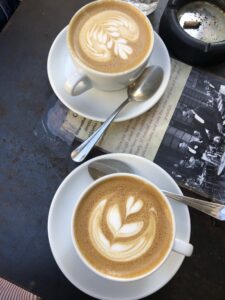
One historic food tradition of Tuscany is called pane toscano, or “Tuscan bread,” which is really just unsalted bread. The story goes that in the ancient rivalry between Florence and Pisa, Pisa blocked shipments of salt from reaching Florence in an effort to force them to capitulate during one of their many battles. Instead, this battle strategy gave birth to one of Tuscany’s famous staples, the best of which can be found in the Province of Lucca (where we were located). It’s definitely worth a try, but moving forward, we’d like some salt with our bread (maybe there’s a reason no one’s clamoring for pane toscano?).
Another item that appears on menus throughout Tuscany is wild boar. The wild boar, or cinghiale, is emblematic of Tuscany, and therefore, should not be missed. This is a dish that the region has perfected and is wonderful as a stand alone or as an addition to a pasta dish. Speaking of pasta, the number one pasta of the area is pasta alla carbonara. The secret of this dish is in its simplicity: it’s a mixture of spaghetti, guanciale (cured hog jowls), garlic, eggs, and Pecorino cheese, which prepared correctly, will have you licking the plate clean.
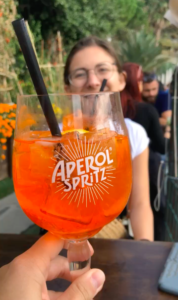
If you’ve been following along with our blogs, it should come as no surprise that we are irrevocably hooked on Aperol Spritzes. We love them so much, that it’s hard to imagine our lives before them. When it comes to this superior beverage, the whole of Italy is in agreement, so do yourself a favor and don’t skip the Aperol spritz.
Now that everyone is Aperol spritz converts, we can talk about the coffee. Coffee is a way of life in Italy, and it’s appropriate to consume all day long. It’s a well known fact that no Italian worth their salt will drink a cappuccino after lunch, but personally, we respectfully turn a blind eye to this ritual and go on drinking cappuccinos well into dinner (shocking, we know). Whether it’s the influx of tourism or a lack of caring, we didn’t get any grimacing looks when ordering our faux pas cappuccinos. The Italians prefer their coffee post-10am in shot form: three ounces of pure espresso that promises to give the jolt you need during that afternoon slump. We think that on everyone’s very first voyage to Italy, do as the Italians do, and experience all the flavors of Italian coffee.
We would be remiss if we didn’t talk about how the extra virgin olive oil in Tuscany might as well be crack. It is unclear how much we actually consumed, but it’s not something we could say no to. We were in Tuscany during the olive harvesting and pressing, and tasting olive oil right off the press is life changing to say the least.
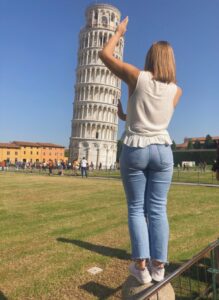 Must sees:
Must sees:
Tuscany is filled with many amazing places that make for great side trips. In order to give each of these destinations the attention they deserve, we will be chronicling our experiences in some of these locations in the near future, so keep a lookout! Some of our top places include:
For history… Florence: This goes without saying, but this destination tops our must sees for obvious reasons. If the city’s ancient and captivating history and charm aren’t convincing enough, the world class food and shopping certainly are.
For wineries… Montecarlo (Italy): Though most people recommend visiting Siena for wineries in Tuscany, we were pleasantly surprised with Montecarlo. We visited here frequently (mostly because of the proximity to our Airbnb), but found the relaxed vibe and wine tastings to be outstanding.
For the best views and hiking… Cinque Terre (technically not Tuscany): For an unexpected hiker’s paradise, these coastal towns grapple the cliffs they are nestled in and feature some of the best (if not the best) Italian food we had in our time here. The name “Cinque Terre” translates to “five lands,” and it’s true. There are 5 coastal towns linked by hiking trails hugging the coastline that feature some of the most spectacular views of the Mediterranean sea.
For capturing “that picture”… Pisa: Most of the information we read before visiting pisa told us to skip it. However, living so close by, we decided to visit anyway and were pleasantly surprised with how likable the little town is. Of course, no trip to Pisa would be complete without getting the picture.
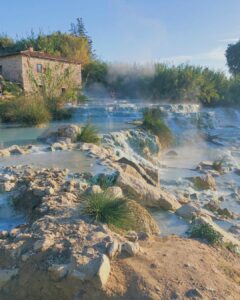
For an out of this world experience... Residing in the small town of Saturnia (even its name pays homage to the Roman god, Saturn, for whom the extraterrestrial planet was named), there is a group of natural hot springs called Cascate del Mulino. These sulphuric springs are located on the grounds of an old mill and feature tiered pools of vibrant milky-blue water cascading down the hillside that makes you feel like you’ve stepped onto another planet. The best part? The pools stay at cozy 99.5°F year-round and entrance is totally free.
For traditional Tuscan countryside... Pienza and Montepulciano: Just south of Florence you will find a region that is world renowned for their red wines, velvety rolling hills, and winding roads lined with cypress trees. When you think of “Tuscany,” this region embodies what image likely comes to mind. We would recommend driving the S.S.146 from Pienza to Montepulciano, but drive slowly and have Google Maps close at hand.
If you’ve read this far, thank you and congrats! You’re all now proficient students of the Rach & Laur Explore Beginner’s Guide to living in the Tuscan Countryside. We hope you can take some of our experiential wisdom and put it to good use! Prego!
